Phil Jefferson, vice president for Western Europe and North Africa, and country manager UK and Ireland at Motorola Solutions; said that the company had spent $553 million on R&D in 2016 and in the same year had spent a further $1.5 billion on acquisitions associated with new technology.
Eduardo Conrado, Motorola Solutions’ EVP – chief strategy and innovation officer (pictured below), added that the company invests in roughly 10-15 start-ups each year and looks for research that could be applied to the world of public safety. He drew attention to the increasing use of voice to access the internet (as seen in the growing use of Alexa and Google Home).
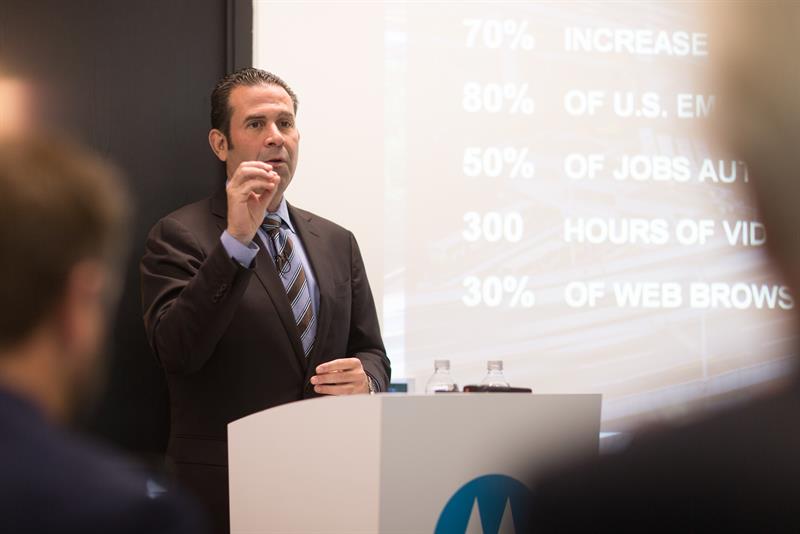
He added that one of the company’s design goals is providing consistency across platforms, both in terms of interface and the data that can be accessed by the user. Conrado also noted that a typical police officer’s time is split as follows:
- • 60 per cent – proactive policing
- • 15 per cent – dealing with incidents
- • 25 per cent – post-incident (filling out forms and other paperwork)
He explained that Motorola is seeking to digitise as much of the post-incident work as possible, so that police officers are free to spend more of their time on proactive policing.
In addition, “We’re working on a full set of applications that enable communication and information sharing across [narrowband] radio and LTE networks and then on the backend [there’s] a lot of emphasis with our data scientists on looking at how we use artificial intelligence and machine learning, not only to improve efficiency, but in some cases to predict where crime will happen.”
He expects there will be greater use of video analytics with it being used to trigger specific actions. Motorola expects that in the near future police officers will be equipped with 360-degree body-worn cameras, augmented reality visors, biometrics and an audio “virtual partner”.
To illustrate the latter, Conrado showed a video in which a policeman had to question a member of the public who only spoke Mandarin and cloud-based real-time translation software allowed him to ask her questions in the same language and hear her translated responses. Conrado said that the company is looking to bring this feature to market next year.
He also discussed another use case in which video analytics can be used in combination with body-worn video to search for a missing person, in this case a child with brown hair and a blue t-shirt, through using the camera’s own processing abilities (intelligence at the network edge). Only when one of the body-worn video cameras in the field detects a match, is data sent back to the control room. Conrado adds that while it might be possible for the officer wearing that camera to initially miss the child, it narrows down their location and it could be possible to use voice/audio prompts to quickly tell the officer where to look. However, Motorola’s current focus is on optimising the processing taking place on the camera rather than the work flows associated with this feature.
He added that one of the issues associated with facial recognition is that it requires that the camera and the face(s) being analysed to be a particular angle to each other, and there are also certain lighting requirements.
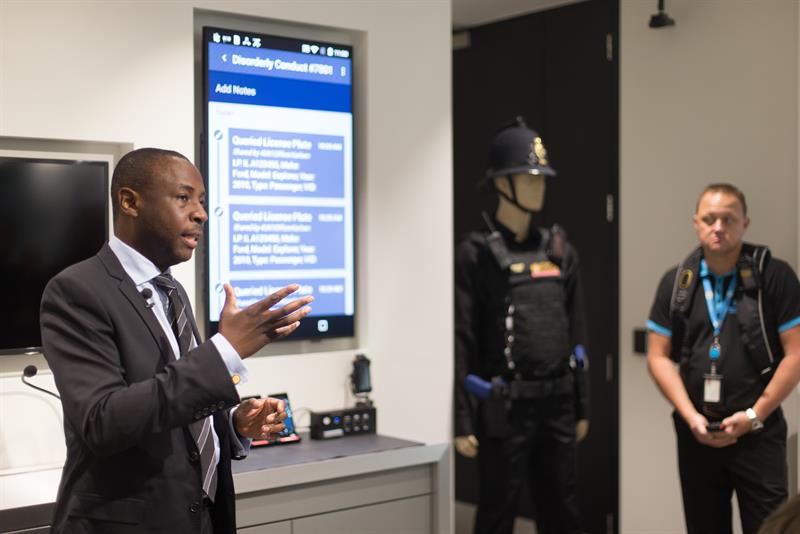
Olatunde Williams, head of field & solutions marketing – Europe & Africa at Motorola Solutions (pictured above left) and his colleague, Adrian Parsons (above, right), senior technical architect, demonstrated a use case for AI combined with natural language processing software. It involved an officer (played by Parsons) in a police car pulling a suspect vehicle over for inspection, with the car’s radio system logging the switching on of the warning lights and other actions.
The officer can vocally request data on the vehicle using commands such as “vehicle check required on licence plate”, “Tell me more about [the vehicle’s registered owner]” and “Any active cases on that vehicle?” and then asking for more information on that case, so that the officer can best assess whether the occupant poses a threat.
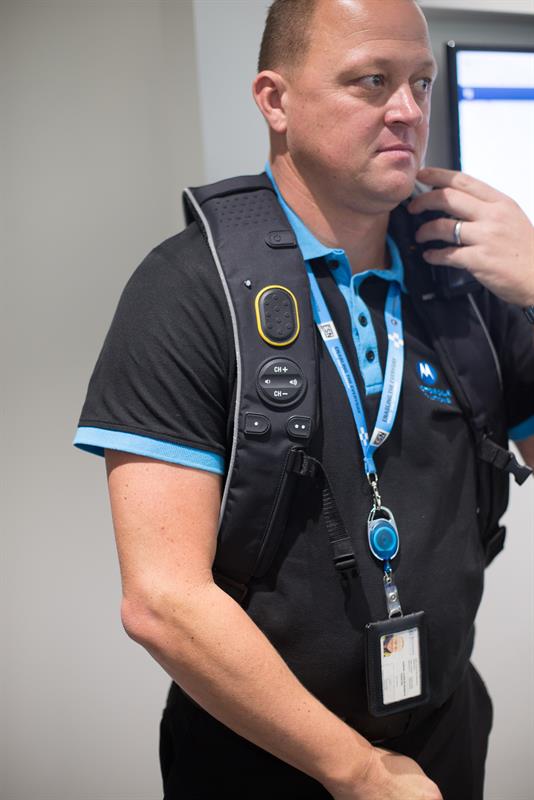
Parsons later explained that the system could be configured to suit an organisations’ business processes and preferences. He also highlighted the current regulations that require police officers to have valid reasons for stopping vehicles and retrieving information about them and their owners, which have to be considered when drawing up these processes.
Parsons wore a radio in the form factor of a jacket (shown above right) and its man-down functionality by dropping it on the ground.
David Parry, Motorola Solutions' director EMEA marketing, and one of his colleagues demonstrated a future fire incident command concept, that uses augmented/mixed reality. In it the incident commander wears an AR headset to see a 3D map of the building in which the fire is taking place (shown below), track the progress of a search within the building (searched areas turn green), view video feeds from cameras worn by the firefighters, unmanned aerial vehicles (UAVs) flying above the incident and 360-degree cameras mounted on fire engines. The commander can via the same AR interface, view the status and movement of the vehicles as they approach the scene, while the status and health of firefighters within the building is shown using different icons.
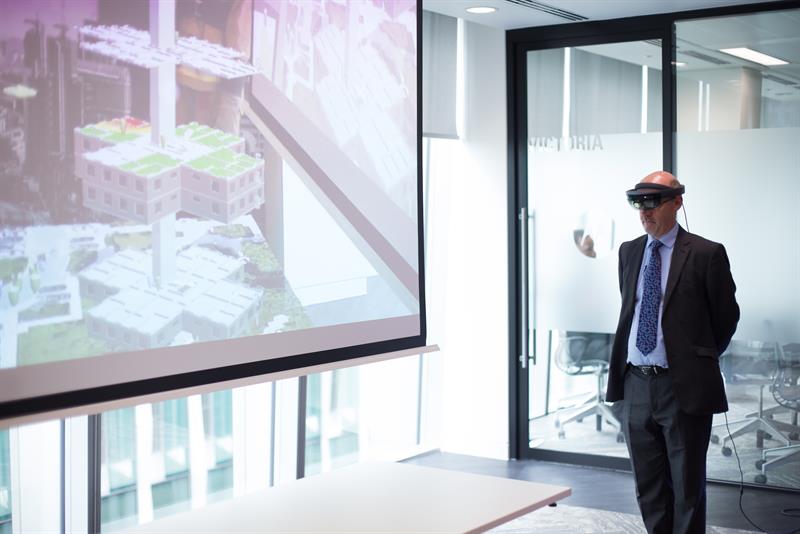
Parry added that the system automatically tracks oxygen consumption, so that should a firefighter be close to running out of air, the icon will change, alerting the commander to the need to order them to withdraw. He notes that currently such timings are measured manually with stopwatches and that the in-building layout functionality requires 3D plans of the building where the incident is taking place to be available.
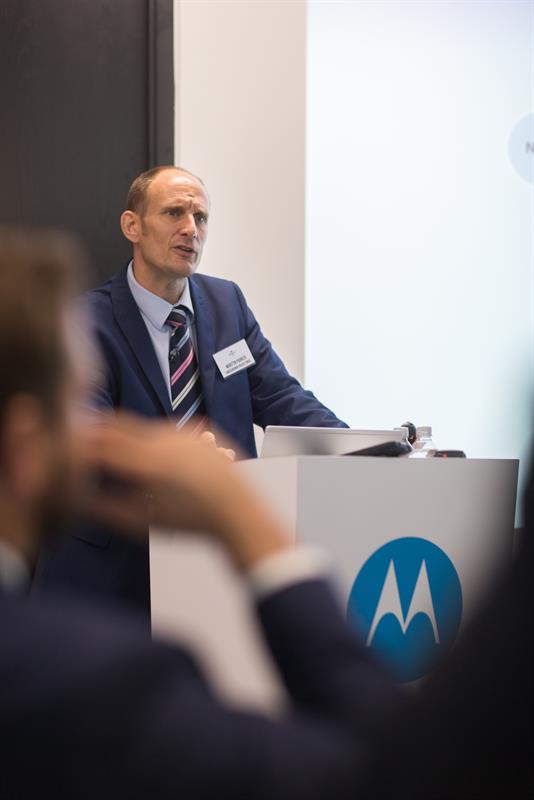
Martyn Parker, Lincolnshire Police's IT Futures programme director (shown left), said that the force spent £2.8 million on a four year Pronto solution supported by 775 mobile devices (the Samsung Note 4). He added that the force is currently looking to upgrade to more modern devices. The force’s use of Pronto is typically saving an hour per shift and has reduced the time required to process road traffic collisions from 30 minutes per booklet to 10 and eliminated the need for paper booklets.
“We have to report on several annual data returns to the Home Office to make sure that our crime compliance, our management and handling of domestic [abuse cases] are accurate and Pronto gives us that security and ability to be able to put and mandate processes in place to make sure that we get compliance from our [frontline] staff,” Parker said. “They’re not always thinking about legislation and policy changes, we push those onto the mobile application…
“When an officer takes a photograph of someone who has been assaulted, a bruised eye or whatever the injury is and they take that picture, the Pronto application will produce that in a format that’s an exhibit, produce it into our records management system (RMS), which can seamless go through to the Crown Prosecution Service (CPS), ensuring that it has all the correct naming conventions, all the detail and accuracy which is required… without another human being needing to interact within the process – it’s really positive time saver for us.”
He said that the application also prompts users to take personal statements from victims of crime, “so they don’t have to continually remember the data they need to capture – the system is helping them do that.”
Parker added that the number of instances in which high risk referrals to the force’s partners for domestic abuse, stalking and harassment cases have been missed have dropped to zero since the process started to be managed by the Pronto mobile data application because of the automated process it used. Prior to its introduction, the force used to miss 7-8 per week.
He also said that City of London Police is deploying an instance of Pronto based on Lincolnshire’s solution. Motorola Solutions is developing a fingerprint solution to search the new Home Office Biometrics Gateway and introducing a mobile mapping and messaging solution integrated with Pronto.
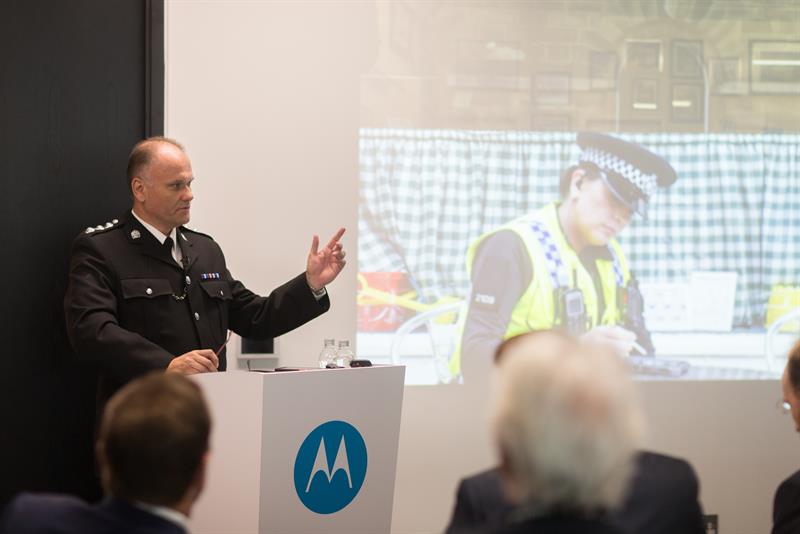
Ian Williams, chief inspector and digital policing lead for West Yorkshire Police (shown above) said that his force is using Pronto for 28 processes, across 5,500 devices and has started using Bluetooth enabled folding keyboards so that officers can more easily enter data onto the system while on the move – they spend around 10,000 hours every month inputting data). He added that West Yorkshire Police wants its officers to be inputting data in locations where they are visible to the public such as a local Macdonald’s, regardless of how this might be portrayed by the tabloids.
He notes that Pronto is “much more timely. For example, someone gets arrested, they get brought back into custody, you’ve got a certain amount of statements and evidence, but you might want a little bit more – you might have missed something. So, you can dispatch an officer to take a statement, upload it and within a minute that can be disclosed to the defence, sent to CPS to get a decision… And we shouldn’t underestimate officers’ access to data [via Pronto], with that integration, you’ve got that full array of data that enables them to make really good decisions and look after the safety of themselves, the public and vulnerable victims.”
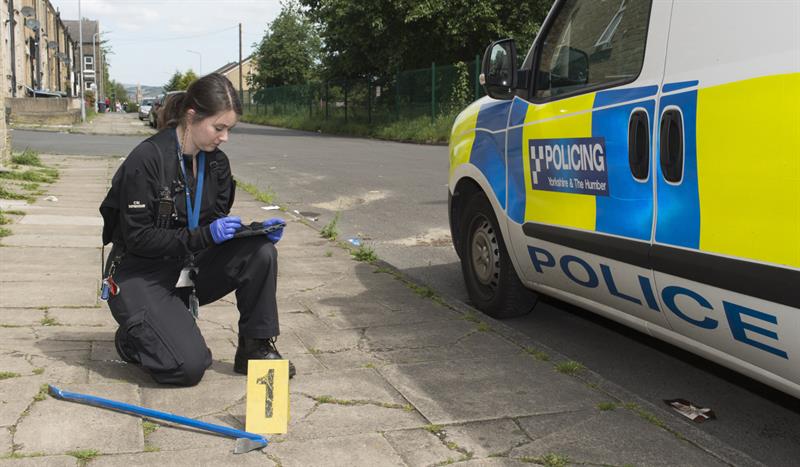
Williams also discussed West Yorkshire Police's use of Pronto Forensics. “CSI integration is a really big one for us, on the back of what we’ve done [with Pronto] for the frontline, we’ve delivered [similar functionality to] crime scene investigators [across] the whole region, there are four forces in our region. Investigators now integrate with several systems, some of them local, some of them national… [allowing] them to collect all their evidence at the scene, bag it up, put it up on the systems and get results coming back before they’ve even left the scene…
“We have investigators who within an hour of [the] initial examination [of a crime scene] are identifying suspects to go out and arrest. We’ve had a murder where a gentleman was badly burnt and the only thing that was recognisable was his hand. We took the fingerprint from that and the result from that enabled us to identify him and subsequently a suspect, in that timescale….,” Williams concluded.
Both Williams and Parker highlighted the advantages of getting involved with suppliers to ensure that their products and services are best suited to forces’ requirements as possible.
Motorola Solutions’ innovations span cellular phones and systems in the mid-80s, to introducing the world’s first TETRA (Terrestrial Trunked Radio) nationwide digital radio network, which is the basis for Airwave – the network went live in 2005 based on Motorola Solutions´ TETRA technology and currently powers public safety communications in the country. Motorola Solutions completed its acquisition of Airwave in February 2016.
In 1994, Motorola Solutions developed radio, cable and antenna systems for the newly opened Channel Tunnel between England and France, and in 1998 CityLink Telecommunications consortium, which included Motorola, was selected to replace and manage the radio transmission services for the entire London Underground Tube network.
Meanwhile, in 2004, Motorola Solutions was selected to provide more than 30,000 MTH800 digital radios for Metropolitan Police Service officers to use on the Airwave nationwide TETRA communications network. London Fire and Emergency Planning Authority’s command and control system went live in May that year and Motorola Solutions supplied and implemented the system.
In 2015, Motorola Solutions was chosen to provide user services, system integration and critical functionality for the UK’s next generation LTE Emergency Services Network (ESN).
Motorola Solutions moved its Europe, Middle East and Africa regional headquarters to London in 2017.



